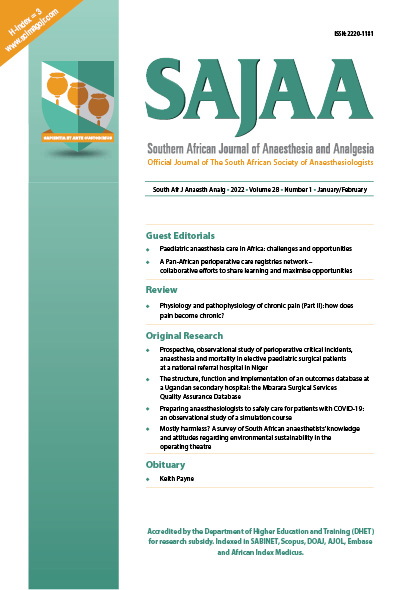Preparing anaesthesiologists to safely care for patients with COVID-19: an observational study of a simulation course
Keywords:
COVID-19, airway management, simulation, personal protective equipment, safetyAbstract
Background: Anaesthesiologists are at high risk for exposure to SARS-CoV-2. We describe the development, implementation and efficacy of a high-fidelity simulation course for anaesthesiologists in response to this threat.
Methods: This is an observational study of preparedness conferred by a simulation course. The following four knowledge gaps were identified: i) personal protective equipment (PPE) selection and donning/doffing; ii) operating room and anaesthesia machine turnover; iii) routine and difficult airway management; and iv) emergent airway management and Advanced Cardiac Life Support (ACLS) protocols. Four simulations were developed and offered to faculty, residents and Certified Registered Nurse Anaesthetists (CRNAs) at an anaesthesiology department. A survey estimated prior knowledge and assessed knowledge gained after the course.
Results: Prior to the simulations, 27% and 26% of the participants estimated ability, respectively, to don and doff PPE, compared to 99% of the participants who demonstrated knowledge after the simulations: donning, odds ratio (OR) = infinity (19.6, infinity); doffing, OR = infinity (19.9, infinity). Prior to the simulations, 28% of the participants estimated knowledge specific to airway management; while after the simulations, 84% of the participants identified correct principles of airway management (OR = 9.1 [4.3, 20.2]). Prior to the simulations, 15% of the participants estimated knowledge of principles guiding emergency airway management and/or ACLS protocols, compared to 94% of the participants who correctly identified those principles after the simulations (OR = infinity [21.9, infinity]). Only 18% of clinicians estimated that they were competent prior to the simulations, while 89% of clinicians demonstrated competency on the written survey after the simulations (OR = 37 [10.8, 212]).
Conclusion: Our results suggest that this simulation course effectively prepared anaesthesiology faculty, residents and staff to select appropriate PPE, and don and doff it, as well as apply best practices during airway management and ACLS protocols.
Downloads
Additional Files
Published
Issue
Section
License
By submitting manuscripts to SAJAA, authors of original articles are assigning copyright to the SA Society of Anaesthesiologists. Authors may use their own work after publication without written permission, provided they acknowledge the original source. Individuals and academic institutions may freely copy and distribute articles published in SAJAA for educational and research purposes without obtaining permission.
The work is licensed under a Creative Commons Attribution-Non-Commercial Works 4.0 South Africa License. The SAJAA does not hold itself responsible for statements made by the authors.

